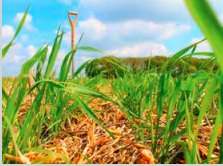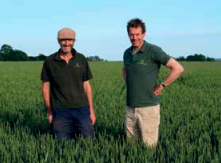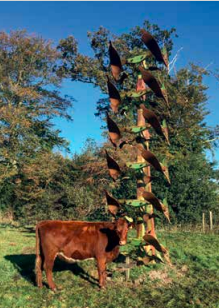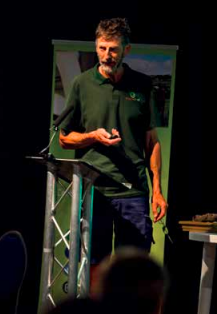
When I was at school, the lights kept going out: we were in the middle of the ‘energy crisis’ of the mid-seventies and the country was struggling to function properly with three day weeks and queues at petrol stations and all the rest. Great fun for us kids, you might as well play outside, if you tried watching the TV, it likely would cut out halfway through your favourite programme. My one distinct memory from that time is watching one of the farm blokes ploughing with what looked like a tiny tractor in an enormous field, puffing black smoke as he slivered up a hill. I remember thinking that there had to be a better way.
Then the energy crisis passed and tractors got bigger and bigger and we could persuade ourselves that ploughing in chopped straw was a sensible way of carrying on. We’d flirted with min-till and direct drilling when we could burn straw, but leaving a mulch of straw on the surface seemed like bonkers behaviour. A couple of visits from Steve Townsend straightened us out on that misconception and we began to cultivate shallower and shallower, year on year. As the soil micro-organism population built up, the straw disappeared and the surface layer of soil grew softer.

Now, we’re not fast learners. Nigh on thirty years had passed since I started thinking we needed a low energy method of growing cereals. We were still burning large quantities of diesel to establish each acre and using the recommended rates of NPK fertilisers. Nitrogen in particular always bothered me; the Haber-Bosch industrial process (which converts Nitrogen gas into Ammonia and onto plant-available forms) is extremely energy intensive. Vast amounts of natural gas are used to make these fertilisers and we are burning up these fossil fuels at a ridiculous rate. Once they’re burnt, they’re gone.
So, when I discovered that there were some brave farmers who were establishing crops straight into stubble, often with a mulch of chopped straw, I got very excited. We visited a few: Simon Cowell, Tony Reynolds and Simon Chiles were particularly inspirational. Not only were they almost strangers to the diesel tank, they were cutting their fertiliser applications.
That’s when we started farming. We bought an old JD 750a drill and we were away. The previous twenty five years had been a warm up. That’s also pretty much when my education began… nearly everything I’d learnt before this moment was of no interest or plain wrong.
A word of thanks to the British Farming Forum, there was a whole community of innovative farmers sharing their experiences and experiments online. When BFF crashed, most of us transferred to TFF’s Direct Drilling section which remains a dynamic forum of ideas and advice as well as a priceless library. I’ve learnt so much more from it than ever I did in three years of reading Agriculture at University. I’ve still no idea who half of the ‘posters’ are, but their advice and encouragement was and is completely invaluable. Not all the advice is sound, of course, but that is part of the education, sifting the wheat from the chaff.

What have I learnt? Quite simply, it’s all about the soil. When we started notill farming, we were excited enough to be growing crops with much reduced overheads. Indeed we had two of our best years ever, in terms of profit. But gradually, I became obsessed by our soils and what we could do to improve them. Undoubtedly we were giving them a chance to improve by the simple expedient of not tilling, or cultivating, them. But, as I was learning from all the books I was now reading and courses I was attending, soil care goes much further.
I don’t remember any mention of soil biology when I was at University. Soil chemistry and physics, yes. But mycorrhizal fungi? Bacteria, protozoa, nematodes, arthropods? I’m sure earthworms got a fleeting mention, but if I hadn’t read Balfour’s The Living Soil and Howard’s An Agricultural Testament I’d have thought farming was all about choosing the right bottles to tip into the sprayer and timing your fertiliser applications just right. It turns out that having a dynamic and healthy soil fauna population is as important, if not more, than the soils physical and chemical make-up.

People have always wanted to get air into their soil so I can see why cultivation makes a certain amount of sense. Unfortunately, it is always a very short term solution as the humus that gives the soil its structure, is oxidised by that air (releasing a fertility boost just when there are no roots to catch it) and the soil-particles thus lose the glue that would otherwise enable them to form a natural structure, complete with gaps through which air and water can pass. What we are aiming for is soil that is a carbon-heavy sponge. It also allows excess water to filter through to the subsoil or drains, win/win.
Anyway, I’m meant to be telling you about our farm. We, my brother Paul and I, are farming 2500 acres, about 2000 of which are in an arable rotation and 500 is permanent pasture. The arable ground has been 100% no-till since 2010 and we’re still experimenting with rotations, in particular we’re struggling to find a broadleaved break crop that is worth bothering with. However we are gradually increasing our beef herd so that we can graze cover crops and incorporate leys into the rotation.

The beef herd is based round two mobs of single suckler cows, mostly Beef Shorthorn cross, which we mob-graze. We have three bulls, two Shorthorn and a Hereford and we keep most of the young after weaning until they are ready to slaughter at 24 to 30 months old. They only get what they graze and silage/hay in the winter, so finishing is slower than with grain fed beasts, but it is cheap and we have no health problems as they are going at a natural pace. We are part of the Pasture Fed Livestock Association, who are trying to secure a premium market price for pasture fed stock. It is so worth it, much more delicious with a healthier balance of amino acids and the rest.

Meanwhile, the cattle are quietly making a few quid and opening up our options on the arable land. They are also producing lots of lovely farmyard manure. We bale about a third of our straw and chop the rest. This straw, together with woodchips we get from local tree-surgeons, balances the N in the dung nicely with lots of Carbon. We’ve just got hold of a compostturner which has resulted in everyone becoming slightly obsessed about compost making. We even bought a lorry-load of ReMin Scotland’s volcanic rock dust to add to the windrow. It is such fun! The potential is enormous, if we can find safe streams of food waste and other industrial cast-offs, it won’t be long before we stop buying any fertiliser.
We haven’t applied any bought P or K fertiliser for ten years or so, our indices remain constant or are rising, so why bother? We stopped using insecticides four or five years ago and haven’t missed them much. We have had the odd patch of BYDV, but the upsides in terms of increased biodiversity, in particular ground beetles which keep the slugs at manageable levels, far outweigh any loss. We are playing around with companion crops as a way to confuse pests and diseases and feed the soil bugs. We are growing cover crops where-ever we have room for them. Above all, we are enjoying ourselves immensely…who knew farming could be such fun?

We started the Groundswell Show four years ago because it seemed only fair to introduce other farmers to the joys of no-till and regenerative farming. It turns out that there are hundreds of farmers out there who are just as interested in their soils as we are and are keen to find out more. It’s a great time to be a farmer, we really could be heroes, come to Groundswell on 26th/27th June to find out how.
